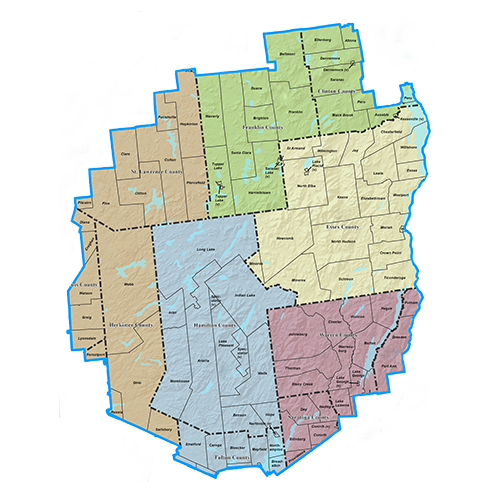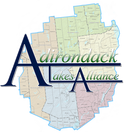Imagine if your town needed to amend New York's state constitution every time they wanted to straighten a rural road or install a broadband internet line. That's exactly the situation for dozens of towns in the Adirondacks and the Catskills that are surrounded by state forest preserve.
But a deal hashed out this week by the legislature is expected to give communities more flexibility, allowing them to use small chunks of Park land without years of delay and red tape.
Need a new power line? Amend the state constitution
Here’s an example of how this works right now. Back in 2009, when the little Adirondack town of Tupper Lake needed a new electric line to end years of power outages and blackouts, the project crossed state forest preserve land. That needed approval from voters statewide – from Long Island to Buffalo.
They literally had to change New York’s state constitution for that one utility project. Richard Kessel, who headed the New York Power Authority, talked at the time about the heavy lift.
"This is a statewide constitutional amendment and we want to see it passed. The worst thing you can have is uninformed voters who, if they see something and there's a lot of language, they just click no. We have to get them to click yes," Kessel said.
This is reality for towns throughout the Adirondacks and Catskills that need something done quickly that involves even tiny chunks of forest preserve park land, which is protected by the state constitution.
A 250-acre pool of land that can be used for must-do projects
But under the plan passed by lawmakers, a 250-acre land bank will be created that local leaders can dip into without all the hassle.
State Senator Betty Little, who represents much of the Adirondack Park says, it will allow communities to take on these small projects without years of politics and a statewide campaign.
"I mean, if you had to do a water well again as we did in Raquette Lake you would be able to do it without a constitutional amendment. And I think it will be beneficial to the Adirondacks and Catskills. Hopefully it will pass muster with the voters in November."
This will need one more statewide vote by New Yorkers; it’ll be on the ballot in November. But it has bipartisan backing, with local leaders on board and also the state’s big environmental groups.
They like the measure because the kinds of projects eligible for the land bank have been narrowly defined in enabling legislation. David Gibson is with the group Adirondack Wild. "It is iron tight; it's one of the best constitutional amendments I can imagine in that way."
This measure does still require towns to go to the state legislature for approval of some projects. Assemblyman Dan Stec says that’s a pain, but it’s still a lot easier than a full-blown constitutional amendment.
"There are some local government officials who would have liked to have less need to go back to the legislature and had more local control over every project. But that was a negotiation that just wasn't going to happen, at least this go around."
All sides agree that approving this deal required a lot of cooperation and compromise from factions in the Adirondacks and the Catskills and within the state legislature that used to fight bitterly over the future of parklands.
"I think we landed in a spot that's valuable to local communities for improving health and safety issues, without jeopardizing or threatening the environmental concerns of the people of the state. So I think we landed in a good spot," Stec said.
This land bank was modeled in part on a similar pool of land that state officials now have access to for road and highway projects in the Parks. Also, the 250 acres that will be used for community projects will be offset by the purchase of new park land.
Source: North Country Public Radio - www.northcountrypublicradio.org/news/story/34218/20170630/land-bank-plan-for-adirondacks-and-catskills-goes-to-voters
But a deal hashed out this week by the legislature is expected to give communities more flexibility, allowing them to use small chunks of Park land without years of delay and red tape.
Need a new power line? Amend the state constitution
Here’s an example of how this works right now. Back in 2009, when the little Adirondack town of Tupper Lake needed a new electric line to end years of power outages and blackouts, the project crossed state forest preserve land. That needed approval from voters statewide – from Long Island to Buffalo.
They literally had to change New York’s state constitution for that one utility project. Richard Kessel, who headed the New York Power Authority, talked at the time about the heavy lift.
"This is a statewide constitutional amendment and we want to see it passed. The worst thing you can have is uninformed voters who, if they see something and there's a lot of language, they just click no. We have to get them to click yes," Kessel said.
This is reality for towns throughout the Adirondacks and Catskills that need something done quickly that involves even tiny chunks of forest preserve park land, which is protected by the state constitution.
A 250-acre pool of land that can be used for must-do projects
But under the plan passed by lawmakers, a 250-acre land bank will be created that local leaders can dip into without all the hassle.
State Senator Betty Little, who represents much of the Adirondack Park says, it will allow communities to take on these small projects without years of politics and a statewide campaign.
"I mean, if you had to do a water well again as we did in Raquette Lake you would be able to do it without a constitutional amendment. And I think it will be beneficial to the Adirondacks and Catskills. Hopefully it will pass muster with the voters in November."
This will need one more statewide vote by New Yorkers; it’ll be on the ballot in November. But it has bipartisan backing, with local leaders on board and also the state’s big environmental groups.
They like the measure because the kinds of projects eligible for the land bank have been narrowly defined in enabling legislation. David Gibson is with the group Adirondack Wild. "It is iron tight; it's one of the best constitutional amendments I can imagine in that way."
This measure does still require towns to go to the state legislature for approval of some projects. Assemblyman Dan Stec says that’s a pain, but it’s still a lot easier than a full-blown constitutional amendment.
"There are some local government officials who would have liked to have less need to go back to the legislature and had more local control over every project. But that was a negotiation that just wasn't going to happen, at least this go around."
All sides agree that approving this deal required a lot of cooperation and compromise from factions in the Adirondacks and the Catskills and within the state legislature that used to fight bitterly over the future of parklands.
"I think we landed in a spot that's valuable to local communities for improving health and safety issues, without jeopardizing or threatening the environmental concerns of the people of the state. So I think we landed in a good spot," Stec said.
This land bank was modeled in part on a similar pool of land that state officials now have access to for road and highway projects in the Parks. Also, the 250 acres that will be used for community projects will be offset by the purchase of new park land.
Source: North Country Public Radio - www.northcountrypublicradio.org/news/story/34218/20170630/land-bank-plan-for-adirondacks-and-catskills-goes-to-voters


 RSS Feed
RSS Feed
